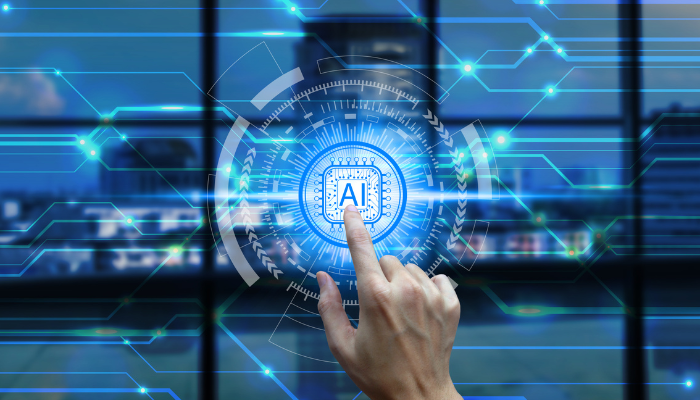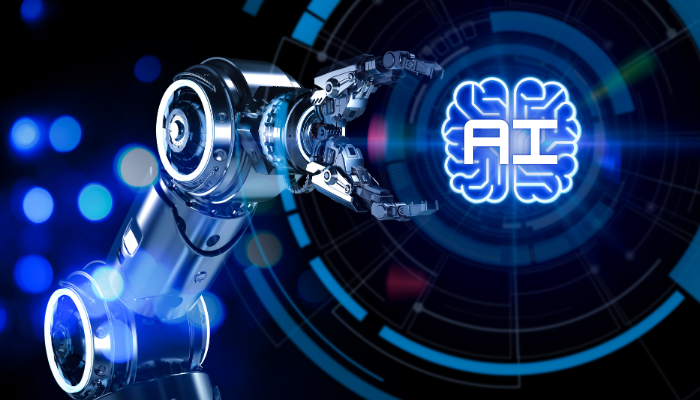If you’re building AI-powered software, you need the right tech stack—one that makes development faster, scalable, and efficient. AI isn’t just about writing code; it’s about building robust models that work in real-world applications without wasting months debugging complex algorithms.
That’s why companies—whether startups experimenting with AI or enterprises deploying machine learning at scale—rely on Python. It’s the go-to language for AI development because it removes the friction from the process, letting teams focus on delivering results instead of getting stuck in technical complexity.
So why is Python the best choice for AI and ML projects? Let’s break it down.
Why Python is Best for AI and ML Projects?
1. Python Makes AI Development Faster and More Scalable
If you’re working with AI, you already know that speed matters—not just in training models, but in shipping products. Python’s clean syntax and extensive libraries mean you can build, test, and deploy AI models faster than in lower-level languages like C++ or Java.
What This Means for Your AI Projects:
- Faster Prototyping = Quicker Time-to-Market: AI development is highly experimental, requiring constant iteration. Python’s simple syntax and pre-built AI/ML libraries (like TensorFlow, PyTorch, and Scikit-learn) let developers test ideas quickly, reducing the time between concept and deployment.
- Less Boilerplate Code = More Focus on Innovation: Python automates complex tasks like data preprocessing, model training, and visualization. With fewer lines of code needed for routine operations, developers can focus on fine-tuning models, improving accuracy, and implementing new features.
- Easier Debugging = Reduced Maintenance Time: Debugging AI applications in lower-level languages can be time-consuming. Python’s interactive environments (like Jupyter Notebooks) allow real-time testing, helping teams identify and fix issues faster. This is especially valuable for large AI models that require ongoing optimization.
For a SaaS product integrating AI features or a custom AI solution for clients, Python allows development teams to iterate quickly, validate models, and integrate AI into production systems without slowing down innovation.
2. Pre-Built AI Libraries Save Development Time
AI development isn’t just about coding—it’s about using the right algorithms, data processing methods, and machine learning models. With Python, you don’t have to start from scratch.
Key Libraries Your AI Team Can Leverage:
- TensorFlow & PyTorch – Frameworks for deep learning and neural networks, enabling everything from image recognition to natural language processing (NLP). These libraries support GPU acceleration for faster model training.
- Scikit-learn – A go-to library for traditional machine learning, offering pre-built algorithms for classification, regression, clustering, and dimensionality reduction.
- Pandas & NumPy – Essential for data manipulation and numerical computing. Pandas simplifies data analysis with structured DataFrames, while NumPy provides optimized array operations for handling large datasets efficiently.
Why This Matters for Business Applications:
- Reduces Development Time and Cost: Instead of building AI models from scratch, businesses can leverage optimized, pre-tested AI algorithms. This speeds up deployment and reduces engineering effort.
- Improves Model Accuracy and Performance: These libraries are backed by extensive research, global developer communities, and constant updates, ensuring businesses use state-of-the-art AI solutions that produce reliable results.
- Scales Effortlessly as AI Requirements Grow: From early-stage startups to enterprise-level AI projects, Python’s libraries support everything from prototyping to full-scale production. Businesses can start with small models and scale up as data volume and AI complexity increase.
For a tech company integrating AI into an existing product, Python makes it easier to plug AI features into your software without building every model from the ground up.
3. Large Developer Community = Faster Problem Solving
AI development doesn’t happen in isolation—your engineering team will inevitably hit roadblocks. With Python, the massive developer community means there’s already an answer to most problems, whether it’s a model optimization issue or a tricky deployment challenge.
How This Helps Your AI Team:
- Faster Debugging and Troubleshooting: Python has one of the largest programming communities, meaning AI engineers can quickly find answers on Stack Overflow, GitHub, and AI research forums. Common AI development issues—from model training errors to performance bottlenecks—often already have documented solutions.
- Access to Thousands of Open-Source AI Projects: The AI/ML space thrives on open-source collaboration. Python developers can leverage pre-built models, reference implementations, and reusable code from open-source AI projects. This accelerates development by reducing the need to build everything from scratch.
- Easier Hiring and Faster Onboarding: Since Python is widely adopted in the AI industry, companies can hire skilled AI engineers more easily compared to niche programming languages. New team members can also onboard quickly because of Python’s readability, extensive documentation, and availability of learning resources.
For AI startups and enterprises scaling their AI teams, this means lower onboarding time, faster problem resolution, and a smoother development cycle.
4. Python Powers AI Across Industries
AI isn’t limited to one type of application—from computer vision and natural language processing (NLP) to recommendation engines and automation, Python is the common denominator across all major AI use cases.
Where Python is Used in AI Solutions:
- E-commerce & SaaS: AI-driven product recommendations, dynamic pricing, automated customer support, fraud detection, and personalized marketing campaigns that increase conversions and retention.
- Healthcare & MedTech: AI-powered medical imaging analysis, early disease detection, predictive patient analytics, personalized treatment plans, and robotic-assisted surgeries that improve accuracy and efficiency.
- FinTech & Banking: AI-driven fraud detection, real-time risk assessment, algorithmic trading, credit scoring, personalized financial assistants, and automated regulatory compliance that enhance security and decision-making.
- Autonomous Tech & Robotics: AI-powered self-driving cars, warehouse automation, smart manufacturing systems, robotic process automation (RPA), and intelligent virtual assistants that improve efficiency and reduce operational costs.
For businesses looking to develop AI-powered products, Python provides the flexibility to build and scale AI features without switching tech stacks as needs evolve.
5. AI Industry Leaders Use Python for a Reason
Python isn’t just popular among startups—it’s the preferred AI language for tech giants, research labs, and AI-first companies.
Who Uses Python for AI?
- Google: Google uses Python to build AI-powered search algorithms, voice recognition in Google Assistant, and its TensorFlow framework, which is one of the most widely used AI tools today.
- OpenAI: The brains behind ChatGPT and DALL·E rely on Python to develop advanced language models, image generation tools, and reinforcement learning research.
- Tesla: Tesla’s self-driving technology runs on AI models written in Python, helping cars recognize objects, predict road conditions, and make driving decisions in real-time.
- Netflix & Spotify: Python helps these platforms analyze user behavior to recommend movies, shows, and music based on past preferences. This AI-driven personalization keeps users engaged.
When companies at this scale trust Python for AI, it’s a clear signal that Python is the right choice for businesses building AI-driven products.
If you’re looking to integrate AI into your product, develop custom machine learning solutions, or scale AI-driven features, Python is the foundation you need.
Want to build AI-powered software with Python? Let’s talk.
So, Where Does Python Fit Into Real AI Development?
1. AI-Powered Chatbots and Virtual Assistants
Python is widely used to develop AI chatbots, voice assistants, and automated customer support systems.
How Python Helps:
- Natural Language Processing (NLP) – Python’s libraries like spaCy, NLTK, and Transformers enable chatbots to process and understand human language, allowing for meaningful interactions.
- Speech Recognition – Python integrates with APIs like Google Speech-to-Text and SpeechRecognition, enabling AI assistants to process voice commands and respond accurately.
- Machine Learning for Intent Detection – AI models built with TensorFlow and Scikit-learn analyze past interactions to predict user intent, making chatbot responses more relevant and personalized.
- Seamless Integration with Messaging Platforms – Python-powered chatbots can be connected to WhatsApp, Facebook Messenger, and Slack, ensuring smooth AI-driven communication across different platforms.
Real-World Example: OpenAI’s ChatGPT is built with Python and leverages deep learning models for conversational AI.
2. AI-Based Recommendation Systems
Whether it’s e-commerce, streaming platforms, or content personalization, Python is behind the recommendation engines that predict what users want next.
How Python Helps:
- Collaborative Filtering – Python-powered AI analyzes user behavior, purchase history, and preferences to suggest similar products, movies, or songs. This is widely used in e-commerce and streaming services.
- Content-Based Filtering – Machine learning models recommend items based on a user’s past interactions, such as articles read, products viewed, or genres preferred. This helps create highly personalized experiences.
- Deep Learning for Personalized AI – Advanced AI models continuously learn from user feedback, fine-tuning recommendations to become more accurate over time. Frameworks like TensorFlow and PyTorch make this possible.
Real-World Example: Netflix and Spotify use Python-based AI models to recommend content tailored to user preferences.
3. Computer Vision and Image Recognition
From self-driving cars to medical imaging AI, Python powers computer vision applications that can interpret and analyze images.
How Python Helps:
- OpenCV for Image Processing – Python’s OpenCV library enables AI systems to detect objects, recognize faces, and track movements in images and videos. It’s widely used in security systems, augmented reality, and medical imaging.
- Deep Learning with TensorFlow & PyTorch – AI models powered by TensorFlow and PyTorch help with advanced vision tasks, such as facial recognition, autonomous vehicle navigation, and medical image analysis.
- OCR (Optical Character Recognition) – Python integrates with Tesseract OCR to extract text from scanned documents, images, and handwritten notes, making it useful for digitizing printed materials and automating data entry.
Real-World Example: Tesla’s self-driving technology relies on Python-powered AI models to recognize objects, roads, and real-time driving conditions.
4. Predictive Analytics and Forecasting
Businesses use Python to analyze past trends and predict future outcomes, whether in finance, marketing, or healthcare.
How Python Helps:
- Scikit-learn for Machine Learning Models: Enables businesses to predict customer churn, stock price trends, and product demand using algorithms like decision trees, regression models, and clustering techniques.
- XGBoost for High-Performance Forecasting: Enhances prediction accuracy in financial markets, risk assessment, and sales forecasting by efficiently handling large datasets and complex patterns.
- Pandas & NumPy for Data Processing: Cleans, structures, and transforms massive datasets, ensuring AI models have high-quality data for accurate predictions and insights.
Real-World Example: Banks and hedge funds use Python-powered AI models to predict stock market trends and detect fraudulent transactions.
5. Autonomous AI and Robotics
Python plays a key role in robotics and automation, from industrial robots to AI-driven drones.
How Python Helps:
- Reinforcement Learning – AI models learn from trial and error to improve decision-making over time, making them essential for robotic navigation, automated control systems, and adaptive learning in machines.
- Robotics Frameworks – Python integrates with ROS (Robot Operating System) to program AI-powered robots for industrial automation, medical robotics, and autonomous vehicles.
- AI for Smart Automation – Python-driven AI optimizes logistics, warehouse operations, and industrial automation by improving efficiency, reducing downtime, and enabling predictive maintenance.
Real-World Example: Amazon’s warehouse robots use Python-based AI models to optimize product picking, packing, and delivery.
Sum up, why Python is the Backbone of AI Across Industries
✔ Versatile – Works for chatbots, vision AI, automation, and predictive analytics.
✔ Efficient – Pre-built AI libraries make development faster.
✔ Scalable – Used by startups and tech giants alike.
Python is more than just a programming language—it’s the foundation for real, business-driven AI solutions.
Python Use Cases for Machine Learning (ML)
Machine learning is at the core of modern AI systems, enabling computers to learn from data and make decisions without explicit programming. Python makes ML development accessible, scalable, and efficient, which is why startups, enterprises, and research labs all rely on it.
Let’s break down where Python is driving real-world machine learning applications.
1. Fraud Detection in Finance & Banking
Financial institutions use machine learning to detect fraudulent transactions in real-time and minimize risks.
How Python Helps:
- Anomaly Detection Models: Machine learning algorithms analyze millions of transactions, identify unusual patterns, and flag suspicious activities, preventing fraud before it happens.
- Supervised Learning for Risk Prediction: AI models trained on historical fraud data assess customer creditworthiness, detect potential risks, and prevent loan defaults.
- Natural Language Processing (NLP) for Security: Python-powered NLP models analyze emails, chat messages, and financial documents to detect phishing scams, fraudulent claims, and security threats.
Real-World Example: Banks like JPMorgan and PayPal use Python-based ML models to prevent fraud and secure online transactions.
2. Personalized Healthcare & Medical AI
Python is widely used in medical research, diagnosis, and personalized treatments powered by ML models.
How Python Helps:
- Medical Image Processing: Machine learning algorithms analyze MRI scans, X-rays, and CT scans to detect diseases like cancer, fractures, and neurological disorders at an early stage, improving diagnosis accuracy.
- Predictive Analytics for Patient Care: AI models assess patient history, symptoms, and genetic data to predict health risks, recommend preventive measures, and assist doctors in early intervention.
- Drug Discovery & Research: Python-powered AI accelerates drug development and testing by analyzing molecular structures, predicting drug interactions, and identifying potential treatments faster than traditional methods.
Real-World Example: Google’s DeepMind uses Python-powered ML models to analyze medical data and predict diseases like diabetic retinopathy.
3. Demand Forecasting in Retail & E-commerce
Machine learning helps retailers predict customer demand, optimize inventory, and reduce supply chain inefficiencies.
How Python Helps:
- Time Series Analysis for Sales Forecasting: Machine learning models analyze past sales trends, seasonal patterns, and market data to predict future demand, helping retailers optimize inventory and reduce stockouts or overstocking.
- Recommendation Engines: AI-driven recommendation systems personalize shopping experiences by suggesting products based on browsing history, purchase behavior, and customer preferences, increasing engagement and conversions.
- AI-Powered Pricing Strategies: Dynamic pricing models adjust product prices in real-time by analyzing competitor pricing, demand fluctuations, and customer purchasing patterns, maximizing profitability while staying competitive.
Real-World Example: Amazon uses Python-based ML models to optimize warehouse inventory and suggest products customers are most likely to buy.
4. Autonomous AI in Manufacturing & Logistics
Python-driven machine learning models are making factories smarter and more efficient by predicting failures before they happen.
How Python Helps:
- Predictive Maintenance: ML models analyze sensor data to detect early signs of equipment failure, allowing businesses to schedule maintenance before breakdowns occur, reducing downtime and repair costs.
- Supply Chain Optimization: AI-powered forecasting predicts demand, improves inventory management, and prevents overstocking or shortages, ensuring smoother logistics and cost efficiency.
- AI for Quality Control: Vision-based machine learning models inspect products in real-time, identifying defects and ensuring consistent manufacturing quality with higher accuracy than manual inspection.
Real-World Example: Tesla’s Gigafactories use Python-powered ML systems to optimize production lines and reduce manufacturing defects.
5. AI-Powered Marketing & Customer Insights
Marketing teams use machine learning to analyze customer behavior, predict trends, and automate ad targeting.
How Python Helps:
- Sentiment Analysis with NLP: AI models process social media posts, product reviews, and customer feedback to gauge public opinion, helping businesses refine their marketing strategies.
- Churn Prediction Models: Machine learning identifies patterns in user behavior to detect customers likely to stop using a service, allowing businesses to take proactive retention measures.
- AI-Optimized Ad Targeting: Dynamic ad models analyze real-time user interactions, browsing behavior, and purchase history to personalize ads, improving engagement and conversion rates.
Real-World Example: Spotify and Netflix use Python-driven ML models to personalize recommendations and predict user preferences.
Sum up, why Python Makes Machine Learning More Accessible and Scalable
✔ Automates decision-making across industries.
✔ Handles large datasets efficiently with powerful libraries.
✔ Works for both small startups and enterprise AI solutions.
Python’s machine learning ecosystem makes it easy to build, train, and deploy ML models that drive real business value.
Need expert Python developers who can bring your AI vision to life? Skip the long hiring process—find out how you can hire top Python talent in just hours here.
Bad data, messy models, and deployment headaches can ruin even the best AI projects. Let’s talk best practices to keep your AI sharp and scalable.
Best Practices for AI and ML Development with Python
Building AI and ML models isn’t just about writing code—it’s about building models that work efficiently, scale properly, and deliver real business value. Python makes AI development easier, but to get the best results, you need to follow best practices that ensure your models are accurate, maintainable, and production-ready.
Here’s how to build better AI and ML solutions using Python.
1. Data is Everything—Clean it First
Your AI model is only as good as the data it learns from. Poor-quality data leads to poor predictions. Before feeding data into a model, make sure it’s:
- Preprocess the Data: Handle missing values, remove duplicates, and normalize datasets to ensure consistency.
- Balance the Dataset: An imbalanced dataset can bias your model, leading to incorrect predictions. Use techniques like oversampling or undersampling if necessary.
- Ensure Correct Labeling: Mislabeling data results in unreliable models and poor decision-making.
Pro tip: Spend more time on data preparation than on model tuning. A good dataset improves model accuracy faster than tweaking hyperparameters.
2. Use the Right Python Libraries for the Job
Python has tons of AI and ML libraries, but picking the wrong one can slow down development.
When to Use Which Library?
- Scikit-learn: Best for traditional ML (classification, regression, clustering).
- TensorFlow / PyTorch: Essential for deep learning, NLP, and image recognition.
- XGBoost: High-performance gradient boosting for structured data analysis.
- OpenCV: Ideal for computer vision tasks, including image and video processing.
Pro tip: Stick to one ML framework per project to avoid unnecessary compatibility issues.
3. Keep Your Models Explainable and Transparent
One of the biggest challenges in AI is understanding why a model makes certain decisions. Black-box AI models can lead to trust issues in industries like finance, healthcare, and legal tech.
- Use SHAP (Shapley Additive Explanations): Helps interpret why a model made a certain decision.
- Log Model Predictions: Tracking outputs over time improves debugging and model transparency.
- Start Simple: Avoid complex deep-learning models unless necessary—traditional ML models often perform just as well.
Pro tip: If a model’s decisions don’t make sense, go back and check your data quality and feature selection.
4. Optimize Model Performance (Without Overfitting)
AI models need to be fast, accurate, and generalizable. But a common mistake? Overfitting—where a model performs well on training data but fails on new data.
- Use Cross-Validation: Apply K-Fold cross-validation to test model performance across multiple subsets.
- Apply Regularization: Techniques like L1/L2 regularization prevent overfitting by penalizing overly complex models.
- Optimize Hyperparameters: Use GridSearchCV or RandomizedSearchCV to find the best model settings.
Pro tip: Always check model accuracy on unseen data before deploying it.
5. Use Version Control for Your AI Models
Unlike traditional software development, AI models change constantly because they learn from new data. Keeping track of which version of a model performed best is critical.
- Use MLflow or DVC (Data Version Control): Keep records of model versions, parameters, and performance.
- Store Model Versions: Save different versions with timestamps, datasets, and hyperparameters for easy rollbacks.
- Automate Model Retraining: Set up CI/CD pipelines for ML models to ensure smooth updates and deployments.
Pro tip: Never deploy an AI model without tracking its performance over time.
6. Deploy AI Models Properly (Not Just in Jupyter Notebooks)
Many teams train great models but fail at deploying them. Running a model locally in Jupyter is different from serving it in production.
- Use Flask or FastAPI: Convert AI models into REST APIs for easy integration with applications.
- Containerize with Docker: Ensure environment consistency across different systems by packaging the model and dependencies into a container.
- Scale with Kubernetes or Cloud Services: Deploy on AWS, GCP, Azure, or Kubernetes to handle real-world traffic and scale as needed.
Pro tip: Always monitor your deployed model’s predictions—data drift happens, and models decay over time.
7. Continuously Monitor and Improve AI Models
AI models are not one-and-done—they need updates as new data comes in. A model that worked six months ago might be outdated today.
- Set Up Monitoring Dashboards: Track accuracy, prediction confidence, and real-world performance using tools like Prometheus, Grafana, or Evidently AI.
- Retrain Models Periodically: Use fresh data to keep models relevant, especially for rapidly changing environments like finance or e-commerce.
- Use MLOps Tools: Automate the AI lifecycle with Kubeflow, SageMaker, or MLflow, making it easier to manage deployments, monitoring, and retraining.
Pro tip: Treat AI models like software—keep iterating and improving them over time.
AI development is an investment—but how much should you budget for it?
Get a breakdown of software development costs and what really drives them here.
How CodeWave Helps You Build AI & ML Solutions with Python
Building AI isn’t just about coding—it’s about turning ideas into real-world applications that work at scale. Whether you’re an enterprise looking to automate processes or a startup building an AI-powered product, having the right development team makes all the difference.
That’s where Codewave comes in.
We don’t just write Python scripts—we engineer AI solutions that are scalable, efficient, and tailored to your business needs.
Here’s how we help:
End-to-End AI & ML Development
From data preprocessing to model deployment, we handle everything. Whether you need a custom AI model, ML-powered analytics, or intelligent automation, our team ensures your AI solution is optimized and production-ready.
What we do:
- Custom AI model development – Predictive analytics, NLP, computer vision, recommendation engines.
- Machine learning model training & optimization – Fine-tuned models that adapt to your business.
- Real-time AI implementation – AI solutions that work fast and scale effortlessly.
Scalable AI Infrastructure for Your Business
Training an AI model in Jupyter Notebook is easy—but making it work in the real world is where things get tricky. Codewave ensures your AI solution is:
- Built for speed & efficiency – No sluggish models that take hours to process data.
- Deployed with Flask, FastAPI, or cloud platforms – So your AI runs seamlessly across applications.
- Containerized with Docker & Kubernetes – So it scales without breaking.
Want your AI to run on AWS, Azure, or GCP? We integrate with all major cloud platforms to make your deployment smooth and cost-effective.
AI That Learns & Improves Over Time (MLOps-Ready)
AI isn’t a one-time build—it needs continuous learning to stay accurate. We don’t just build AI models; we set up monitoring and retraining pipelines so your AI keeps improving.
- Data pipelines – Automate data collection, preprocessing, and retraining.
- Model tracking & performance monitoring – No more “Why did the AI fail?” moments.
- MLOps for AI automation – Fully managed AI workflows that retrain models without manual intervention.
AI-Powered Solutions Tailored to Your Industry
AI is not one-size-fits-all—that’s why we specialize in industry-specific solutions:
- Education & SaaS: AI-driven personalization enhances learning experiences, while predictive analytics helps improve user engagement and retention. Fraud detection ensures secure transactions and data integrity.
- Healthcare & MedTech: AI powers medical diagnostics, medical imaging, and predictive patient insights, improving early disease detection and treatment planning.
- FinTech & Banking: AI strengthens risk assessment, automates financial forecasting, and powers intelligent chatbots for seamless customer service.
- Retail & Logistics: AI-driven demand forecasting improves inventory management, while supply chain optimization reduces operational inefficiencies and enhances delivery accuracy.
Whatever your AI vision, we make it happen with Python development.
Let’s Build AI That Works for Your Business[Contact Us]
Let’s Build AI That Works for Your Business
Codewave is a UX first design thinking & digital transformation services company, designing & engineering innovative mobile apps, cloud, & edge solutions.






